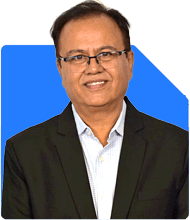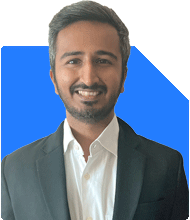Ramalingam Kalirajan |10893 Answers |Ask -Follow
Mutual Funds, Financial Planning Expert - Answered on Jul 12, 2024
He has an MBA in finance from the University of Madras and is a certified financial planner.
He is the director and chief financial planner at Holistic Investment, a Chennai-based firm that offers financial planning and wealth management advice.... more

I am 41 years ,with 1.1 crores in MF with monthly sip of 1 lac,50 Lacs in gold,10 lacs in LIC ,10 lacs in emergency fund 1 loan free flat.I have a loan running for the car. I have two sons aged 7 and 10 I would like to retire at 50 with monthly passive income of minimum 5 lacs. Kindly share investment ideas
Rs. 1.1 crores in mutual funds with a monthly SIP of Rs. 1 lakh.
Rs. 50 lakhs in gold.
Rs. 10 lakhs in an LIC policy.
Rs. 10 lakhs in an emergency fund.
A loan-free flat.
A running car loan.
Two sons aged 7 and 10.
You aim to retire at 50 with a passive monthly income of Rs. 5 lakhs. This goal is ambitious but achievable with the right strategy.
Assessing Your Investment Portfolio
Mutual Funds
Your investment in mutual funds is significant and shows a strong commitment to growth. However, it's crucial to review the types of mutual funds you're invested in. Diversification across large-cap, mid-cap, and small-cap funds is essential.
Actively managed funds tend to perform better than index funds in the long term. Actively managed funds are managed by professionals who aim to outperform the market. They offer better growth potential, especially in a volatile market.
Gold
Gold is a stable asset that can protect against inflation. However, it might not provide the growth needed to achieve your retirement goal. It’s advisable to limit gold to a smaller percentage of your portfolio.
LIC Policy
LIC policies often come with lower returns compared to mutual funds. Considering the goal of achieving a passive income of Rs. 5 lakhs per month, you might want to reconsider this investment.
Emergency Fund
Having Rs. 10 lakhs in an emergency fund is prudent. This ensures you have liquidity in case of unforeseen circumstances.
Real Estate
Owning a loan-free flat is a significant asset. While real estate is not recommended as an investment option here, your flat provides stability and reduces living expenses.
Car Loan
Managing your car loan efficiently is crucial. Ensure it doesn’t become a burden on your finances.
Strategic Investment Recommendations
Increase Equity Exposure
To achieve a substantial passive income, consider increasing your exposure to equities. Equities have the potential for higher returns compared to other asset classes.
Diversify Within Mutual Funds
Diversify your mutual fund investments across different sectors and market capitalizations. Include a mix of large-cap, mid-cap, and small-cap funds. This strategy spreads risk and capitalizes on various market opportunities.
Reduce Gold Allocation
While gold is a safe investment, it’s wise to reduce its allocation. You could redirect some of the funds in gold towards more growth-oriented investments like equities.
Reevaluate LIC Policy
Considering the lower returns from LIC policies, you might want to surrender the policy and reinvest the proceeds in mutual funds. This shift can enhance your overall portfolio returns.
Increase SIP Contributions
Your current SIP of Rs. 1 lakh per month is commendable. To accelerate growth, gradually increase this amount as your income allows. This practice is known as the ‘step-up SIP’ strategy.
Focus on Actively Managed Funds
Actively managed funds can potentially provide better returns than index funds. Fund managers actively make decisions to outperform the market, offering higher growth potential.
Emergency Fund Maintenance
Maintain your emergency fund to cover at least six months of expenses. This ensures financial security without hindering long-term investments.
Planning for Children's Future
Education Fund
Consider setting up dedicated funds for your children’s education. Investing in child-specific mutual funds or SIPs can help accumulate a substantial corpus over time.
Financial Security
Ensure you have adequate term insurance to protect your family. A term plan provides a financial cushion in case of unforeseen events.
Retirement Planning
Calculate Retirement Corpus
To achieve a monthly passive income of Rs. 5 lakhs, you need a substantial retirement corpus. Assuming a conservative withdrawal rate, you might need a corpus of around Rs. 12 crores.
Increase Retirement Contributions
Increase your monthly SIP contributions. Regularly review and adjust your investments to stay on track towards your retirement goal.
Focus on Growth-Oriented Investments
Prioritize growth-oriented investments like equities and high-performing mutual funds. They can offer the necessary growth to build your retirement corpus.
Diversify Investments
Diversify across asset classes to manage risk and ensure steady growth. Include a mix of equities, debt instruments, and other high-yield investments.
Regular Review and Rebalancing
Regularly review your portfolio to ensure it aligns with your retirement goals. Rebalance your investments to maintain the desired asset allocation.
Generating Passive Income
Dividend-Yielding Investments
Consider investments that provide regular dividends. Dividend-yielding stocks and mutual funds can offer a steady income stream.
Systematic Withdrawal Plan (SWP)
Implement a Systematic Withdrawal Plan in mutual funds. SWPs allow you to withdraw a fixed amount regularly, providing a stable income during retirement.
Rental Income
If possible, consider generating rental income from your property. Rental income can supplement your passive income needs.
Senior Citizen Savings Scheme (SCSS)
After retirement, invest in the Senior Citizen Savings Scheme. SCSS offers a secure and regular income for senior citizens.
Monthly Income Plans (MIPs)
Invest in Monthly Income Plans which provide regular payouts. MIPs balance growth and income, ensuring a stable cash flow.
Final Insights
Achieving a monthly passive income of Rs. 5 lakhs is a challenging but attainable goal. Focus on increasing your equity exposure, diversifying your investments, and regularly reviewing your portfolio. Actively managed mutual funds can offer better returns compared to index funds.
Consider reducing gold allocation and reassessing your LIC policy. Ensure you have adequate insurance coverage and an emergency fund. Plan for your children’s education and future needs.
Gradually increase your SIP contributions and focus on growth-oriented investments. Implement strategies like SWP and dividend-yielding investments for passive income. Regularly review and rebalance your portfolio to stay aligned with your retirement goals.
Best Regards,
K. Ramalingam, MBA, CFP
Chief Financial Planner
www.holisticinvestment.in
You may like to see similar questions and answers below
Sunil Lala | Answer |Ask -Follow
Financial Planner - Answered on Nov 05, 2023
Ramalingam Kalirajan |10893 Answers |Ask -Follow
Mutual Funds, Financial Planning Expert - Answered on May 25, 2024
Vivek Lala |323 Answers |Ask -Follow
Tax, MF Expert - Answered on Jun 16, 2024
Ramalingam Kalirajan |10893 Answers |Ask -Follow
Mutual Funds, Financial Planning Expert - Answered on Jul 09, 2025
Ramalingam Kalirajan |10893 Answers |Ask -Follow
Mutual Funds, Financial Planning Expert - Answered on Sep 11, 2025
Ramalingam Kalirajan |10893 Answers |Ask -Follow
Mutual Funds, Financial Planning Expert - Answered on Dec 15, 2025
Ramalingam Kalirajan |10893 Answers |Ask -Follow
Mutual Funds, Financial Planning Expert - Answered on Dec 15, 2025
Radheshyam Zanwar |6746 Answers |Ask -Follow
MHT-CET, IIT-JEE, NEET-UG Expert - Answered on Dec 15, 2025
Ramalingam Kalirajan |10893 Answers |Ask -Follow
Mutual Funds, Financial Planning Expert - Answered on Dec 15, 2025
Ramalingam Kalirajan |10893 Answers |Ask -Follow
Mutual Funds, Financial Planning Expert - Answered on Dec 15, 2025
Ramalingam Kalirajan |10893 Answers |Ask -Follow
Mutual Funds, Financial Planning Expert - Answered on Dec 15, 2025
Samraat Jadhav |2508 Answers |Ask -Follow
Stock Market Expert - Answered on Dec 15, 2025
Ramalingam Kalirajan |10893 Answers |Ask -Follow
Mutual Funds, Financial Planning Expert - Answered on Dec 15, 2025
Reetika Sharma |425 Answers |Ask -Follow
Financial Planner, MF and Insurance Expert - Answered on Dec 15, 2025
Radheshyam Zanwar |6746 Answers |Ask -Follow
MHT-CET, IIT-JEE, NEET-UG Expert - Answered on Dec 15, 2025


























